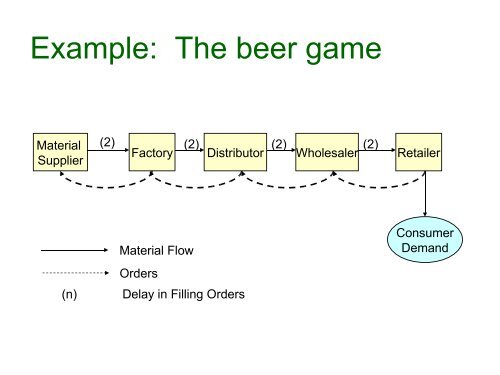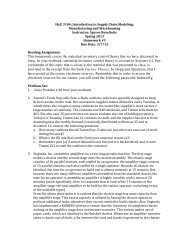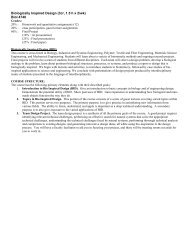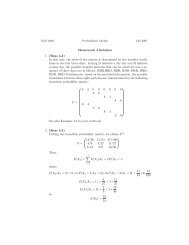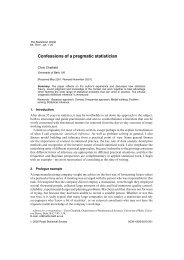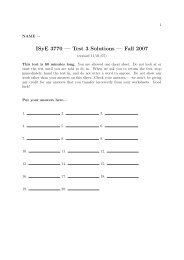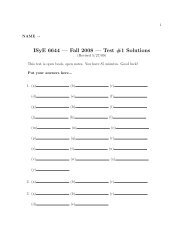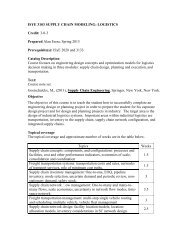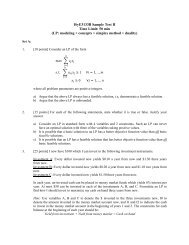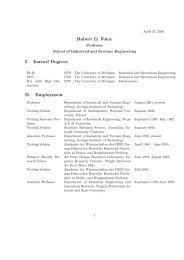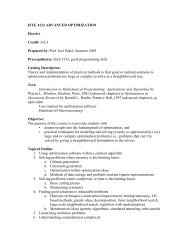Example: The beer game
Example: The beer game
Example: The beer game
You also want an ePaper? Increase the reach of your titles
YUMPU automatically turns print PDFs into web optimized ePapers that Google loves.
<strong>Example</strong>: <strong>The</strong> <strong>beer</strong> <strong>game</strong><br />
Material<br />
Supplier<br />
(2) (2) (2) (2)<br />
Factory Distributor Wholesaler Retailer<br />
(n)<br />
Material Flow<br />
Orders<br />
Delay in Filling Orders<br />
Consumer<br />
Demand
For each period<br />
• Fill the orders in the backlog file<br />
• Receive material from supplier<br />
• Place order with supplier<br />
• Receive order -- adjust the backlog
Operating cost penalties<br />
• <strong>The</strong>re are two operating costs:<br />
• 0.50 per unit inventory per period<br />
(this is the carrying cost)<br />
• 1.00 per unit unsatisfied demand<br />
(this is to ensure good service)
Variability<br />
Higher variability in orders placed by retailer than actual sales
Bullwhip effect<br />
Supplier<br />
Manufacturer<br />
Distributer/<br />
Wholesaler<br />
Retailer<br />
Consumer<br />
Sales<br />
Sales<br />
Sales<br />
Sales<br />
Sales<br />
Time<br />
Time<br />
Time<br />
Time<br />
Time<br />
Increase in variability as we move up in the supply chain.
What are the reasons?
Reasons<br />
• Demand Forecast Updating - each<br />
company in a supply chain forecasts<br />
demand myopically (i.e. based on past<br />
demand from their own direct<br />
customers)<br />
• Order Batching - companies placing<br />
orders on upstream suppliers usually do<br />
so periodically to save on<br />
transportation/ transaction costs.
Reasons continued<br />
• Price Fluctuation - frequent price changes<br />
(both up and down) lead buyers to purchase<br />
large quantities when prices are low and<br />
avoid buying when prices are high.<br />
• Rationing and Shortage Gaming - cyclical<br />
industries face alternating periods of<br />
oversupply and undersupply. When buyers<br />
know that a shortage is imminent and<br />
rationing will occur, they often increase the<br />
size of their orders (and vice-versa).
Multi-stage supply chains<br />
Consider a multi-stage supply chain:<br />
• Stage i places order q k to stage k+1.<br />
• L k<br />
is lead time between stage k and k+1.<br />
• Demand has mean D and standard deviation σ<br />
q o =D q 1 q 2<br />
Retailer<br />
Stage 1<br />
Manufacturer<br />
Stage 2<br />
L 1 L 2<br />
Supplier<br />
Stage 3
Variability as a function of stages<br />
Var(q k )/σ 2 σ 2<br />
30<br />
25<br />
k=5<br />
20<br />
15<br />
10<br />
5<br />
0<br />
k=3<br />
0 5 10 15 20 25
Impact of batch ordering<br />
• Why batch ordering?
Impact of batch ordering<br />
• Why batch ordering?<br />
• Fixed ordering costs<br />
• P&G estimates that the cost of placing an order with manual<br />
interventions is $35-$75<br />
• Transportation costs<br />
• Ordering FTL vs. LTL<br />
• Sales quotas or incentives<br />
• “push” ordering or “forward” buying<br />
• If the retailer uses batch ordering, the wholesaler will see<br />
spikes in orders in certain periods followed with no orders for<br />
several periods<br />
• A distorted and highly variable pattern of orders at the<br />
upstream channel
Variable pricing<br />
• Price fluctuations cause forward buying<br />
• Price/quantity discounts, Rebates, Trade deals<br />
• Customers buy in quantities that do not reflect their immediate needs<br />
• Variation of the buying quantities is larger than the variation of the<br />
consumption rate<br />
• Possible remedy: Everyday low pricing<br />
Order Quantity<br />
800<br />
600<br />
400<br />
200<br />
Bullwhip Effect due to Seasonal Sales of<br />
Soup<br />
Shipments from<br />
Manufacturer to<br />
Distributors<br />
Retailers’ Sales<br />
0<br />
1 Weeks<br />
52
Inflated orders (rationing <strong>game</strong>)<br />
• During shortage periods manufacturers allocate products to<br />
customers proportional to order size<br />
• e.g., if total supply is 50% of total orders, all customers receive<br />
50% of what they order<br />
• Inflated or duplicate orders during shortage periods<br />
• Returns and cancellations later<br />
• Customer orders give little info to the supplier<br />
• <strong>Example</strong>: Motorola cell phones<br />
• Shortage during Christmas season<br />
• Excess ordering in the following year, record 4th quarter earnings<br />
• Channels swamped with inventory, stock tumbled almost 10%<br />
• Possible remedy: allocation based on past sales
Information sharing<br />
• Demand (sales data, forecasts)<br />
• New stores<br />
• Promotions<br />
• Inventory levels, product quantities<br />
available for purchase<br />
• e.g., Sears, Okuma Corporation<br />
• Production and distribution schedules<br />
• more accurate lead times<br />
• Order status/tracking
Bypassing channels (common<br />
access to demand information)<br />
Traditional<br />
retailer<br />
Farm Importer Wholesaler Florist Customer<br />
8-12 days<br />
PUSH<br />
PULL<br />
Direct<br />
from farms<br />
Farm<br />
Proflowers.com<br />
Customer<br />
1-2 days<br />
PUSH<br />
PULL
Access to demand information<br />
in supply chains<br />
• Bypassing a downstream site in the supply chain<br />
• e.g., Dell Computers, Proflowers.com<br />
• Information sharing<br />
• <strong>The</strong> partners are given access to a system that has<br />
the shared information in it<br />
• e.g., Wal-Mart RetailLink system<br />
• One partner transmits shared information to the other<br />
partner<br />
• Shared information is stored in an “information hub”
Collaborative forecasting<br />
• Include multiple factors about future demand<br />
• past sales, pricing, promotions, new products<br />
• Who controls or has information about these<br />
factors?<br />
• E.g., retailer may control pricing, promotions,<br />
products from other competitors<br />
• Collaborative forecasting<br />
• an iterative forecasting process in which all<br />
participants in the supply chain collaborate to arrive at<br />
an agreed upon forecast<br />
• e.g., Wal-Mart and Warner-Lambert (CPFR)<br />
• eliminate 2 weeks of inventory; cut cycle times in half
Vendor Managed Inventory<br />
• Both parties must understand and agree<br />
the stocking plan the manufacturer will be<br />
using.<br />
• Frequency of replenishment (daily?<br />
once/twice per week?), replenishment<br />
quantity, etc.<br />
• <strong>The</strong> Distributor sends the manufacturer<br />
• POS history file, usually 1-2 years.<br />
• Information on the status and stock level of<br />
every item they have
Incentive Alignment<br />
• Incentive problems occur due to:<br />
• Hidden actions by partner firms<br />
• Informational asymmetries<br />
• Poorly designed incentive schemes
Hidden action example<br />
• Sears sells both Whirlpool and Kenmore<br />
(their private-label brand) washing<br />
machines<br />
• Whirlpool is relying of Sear’s salespeople<br />
• Whirlpool can’t easily track effort of<br />
salespeople pushing their brand compared<br />
to Kenmore<br />
• This hidden action makes it difficult for<br />
Whirlpool to determine proper incentives
Information asymmetries<br />
• Many partners are reluctant to share their<br />
data<br />
• Vendor for a manufacturer may be reluctant to<br />
share cost data<br />
• Company may be fearful to share certain<br />
design data with contract manufacturer<br />
• When there is hidden data in a supply<br />
chain, it can hurt efficiency
Poorly designed schemes<br />
• <strong>Example</strong>: Grocery store has a vendor<br />
managed inventory relationship with a<br />
dairy farm for milk<br />
• Store allocates shelf space for milk provider<br />
• Store pays provider at delivery<br />
• Provider has responsibility for stocking<br />
• Q: What will be the impact of this policy?<br />
• Q: What might eliminate this problem?
How to tackle incentive problem?<br />
• Acknowledge when this is a problem<br />
• Common with new initiatives since this can<br />
modify incentives of key stakeholders<br />
• Find the cause<br />
• Hidden action, hidden information, badly<br />
designed incentive<br />
• Redesign incentives<br />
• Contracting, revealing information,<br />
independent party (intermediaries)
1. Contracting<br />
• Most straight forward approach<br />
• Contracts can “unhide” actions<br />
• Blockbuster example<br />
• Q: What could be done with the Whirlpool/<br />
Sears case?<br />
• Difficulty – impossible to contract against<br />
all conditions
<strong>Example</strong> – Tweeter and Bryn Mawr<br />
• Bryn Mawr (acquired by Tweeter in 1996) seller<br />
of electronics<br />
• Bryn Mawr deducted full value of stolen goods<br />
from manager’s pay<br />
• Result – kept impulse-based purchases locked up<br />
(e.g., batteries, audiotapes, etc.)<br />
• Sacrificed sales for shrink reduction<br />
• Tweeter changed contract – paid managers<br />
based on % of profits, and profits increased<br />
significantly
2. Revealing hidden information<br />
• Tracking and monitoring<br />
• Use of agents to collect data (third party,<br />
spy) such as a “mystery shopper”
3. Intermediary<br />
• Has become more prevalent with<br />
outsourcing since contracts can be hard to<br />
enforce in certain countries<br />
• Fear of contractors engaging in behavior such<br />
as bribery, child labor, etc.<br />
• Intermediary can help align incentives<br />
between parties
Li & Fung example<br />
• Created a network of factories in Asia<br />
• Enforce a code of ethics for participation<br />
• Wage, hygienic work conditions, etc.<br />
• Monitors suppliers through use of chief<br />
compliance officer<br />
• Cuts companies off if make unreasonable<br />
demands of suppliers or don’t take delivery<br />
• <strong>The</strong>ir size helps them to do this and that they<br />
account for about half of volume for their<br />
suppliers
Conclusions<br />
• Incentives are key to supply chain<br />
performance<br />
• Although issues are challenging to<br />
address, companies should spend time<br />
studying this problem in their supply<br />
chains


